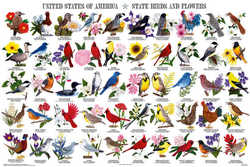
Mississippi Symbols
Mississippi State Bird
Mockingbird

(Mimus polyglottos)
Adopted in February 23, 1944.
The Women's Federated Clubs of Mississippi held a state bird campaign, selecting the mockingbird, (Mimus polyglottos.) A bill to designate the mockingbird Mississippi's official state bird was submitted in 1944. The mockingbird was signed into law on February 23, 1944.
The Northern Mockingbird, clad in shades of gray with conspicuous white wing patches, enjoys exceptional popularity for such a drab specimen, evident
in the fact that it is the state bird of Arkansas, Florida, Mississippi,
Tennessee and Texas.
Mississippi State Bird: Mockingbird

Mockingbirds are gray with white patches on their wings. They grow to be about 11 inches long. Mockingbirds copy, or mock, the sounds and songs of other birds
The Mimus polyglottos, as the mockingbird is known scientifically, is about ten inches in length, including its relatively long tail. It has a light gray coat and a whitish underside. Its wings and tail are darker gray with white patches. The male and females look alike. Juvenile has spotted breast.
The common mockingbird is a superb songbird and mimic. Its own song has a pleasant lilt, varied and repetitive. Often it will sing all night long, especially in bright springtime moonlight. Unmated male mockingbirds sing more than mated ones. Both sexes sing in the fall to claim winter feeding territories. These areas are often different than their spring breeding territories.
The song of the mockingbird is, in fact, a medley of the calls of many other birds, each repeated several times. It will imitate other species' songs and calls, squeaky gates, pianos, sirens, barking dogs, etc. Each imitation is repeated two or three times, then another song is started, all in rapid succession. In the above sample audio file, the songs of four distinct species were recorded in the span of about seven seconds. It is common for an individual bird to have as many as 25-30 songs in its repertory.
The mockingbird is also known as a fierce protector of its nest and environment. It is sometimes seen swooping down on a dog, cat or predator that may be venturing too close to the bird's protected territory.
Characteristics of the Mockingbird
- Abundance: Common urban bird
- Length: 10 inches
- Weight: 1-3/4 ounces
- Wing Span: 14 inches
- General description: Diurnal, omnivore, altricial
- Sexual maturity: 1 year
- Mating season: Spring and early summer. Mockingbirds usually nest twice a year sometimes 3 or 4 times when conditions are favorable.
- Breeding territory: 1 pair per 20 acres
- Gestation: Eggs hatch in 12-13 days, the young fledge 11-13 days after that.
- Number of young: Eggs are blue-green with brown markings. The 2-6, usually 3-5, eggs per nest are a pale blue-greenish with brown spots.
- Nest Location: Ground-low nesting
- Nest Type: Open-cup The nest, a joint male/female project, is a bulky, open cup of grass, twigs and rootlets carelessly arranged in a dense.
- Migration Status: Permanent resident. This year-round resident is known for its fierce defense of the family nest.
- Diet: Mockingbirds require open grassy areas for their feeding, thick, thorny shrubs for hiding the nest and high perches where the male can sing and defend his territory. Gardens are among its favorite dwelling places especially if winter berries are available. The Mockingbird's primary diet is insects (beetles, ants, grasshoppers and spiders), berries and seed.
Facts about the Mockingbird:
- Only unmated males sing at night.
- Mockingbirds often form long-term pair bonds.
- Mockingbirds vigorously defend their territory against many other species including dogs, cats and man!
- Female mockingbirds often build a new nest while the males finish feeding older fledglings and teaching them to fly.
- Scientists have found that female mockingbirds are attracted to males that can make the most different sounds.
- Mockingbirds are the state bird of Arkansas, Florida, Mississippi, Tennessee, and Texas and one of the few birds found in every kind of habitat, from desert to forest to city.
- Mockingbirds are thought to raise and lower their wings in order to scare up a meal of insects, frighten snakes and impress their mates.
2013 Mississippi Code
The law designating the mocking bird, or mockingbird as the official Mississippi state bird is Section 3-3-11 (State bird) of the Mississippi Code, specifically Title 3 (STATE SOVEREIGNTY, JURISDICTION AND HOLIDAYS) Chapter 3 (STATE BOUNDARIES, HOLIDAYS, AND STATE EMBLEMS) Section 3-3-11.
Title 3 - STATE SOVEREIGNTY, JURISDICTION AND HOLIDAYS
Chapter 3 - STATE BOUNDARIES, HOLIDAYS, AND STATE EMBLEMS
§ 3-3-11 -
Universal Citation: MS Code § 3-3-11 (2013)
The bird commonly called the mocking bird is hereby designated the state bird of the State of Mississippi.
Taxonomic Hierarchy: Northern Mockingbird
Kingdom: Animalia (animal)
Phylum: Chordata (chordates)
Subphylum: Vertebrata (vertebrates)
Class: Aves (birds)
Order: Passeriformes (perching birds)
Family: Sturnidae (starlings)
Genus: Mimus Boie, 1826 (mockingbirds)
Species: Mimus polyglottos (Linnaeus, 1758) - Centzontle norteno (northern mockingbird)
Scientific Name: Mimus polyglottos
Taxonomic Serial Number: 17862







